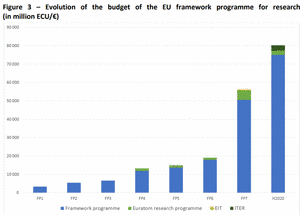V. Reillon, EPRS (European Parliamentary Research Service), 38 pages, September 2017, ISBN: 978-92-846-1687-9
This in-depth analysis of the European framework programmes (FPs) for research feeds into the current discussions on the structure and priorities of the future FP9, i.e. the successor of Horizon 2020. The report provides a historical perspective of the evolution of the FPs, starting from the FP1, adopted in 1983 and landing to Horizon 2020. This interesting excursus gives readers the possibility to see how, through successive modification of its legal basis research, the FPs for research have become more and more a fully-horizontal, truly European policy. Here is a summary of the main developments, according to the author:
- FP1 (1984-1987): adopted in 1983, it made the FP not only a programming tool but also a financial one, meant to address the economic crisis and support Member States’ competitiveness. It revolved around six thematic priorities (agriculture, industrial competitiveness, raw materials, energy, development aid and living conditions).
- FP2 (1987-1991): similar structure as FP1, but special focus on access and support to research infrastructure, research worker mobility, support for actors in the innovation process, including small and medium-sized enterprises (SMEs) and the involvement of non- European Community countries in the programme.
- FP3 (1991-1994): while completion of the single market was still a major aspect in the development of the FP, others were also added, such as introducing a European dimension to research training, boosting economic and social cohesion, and including aspects regarding environmental protection and quality of life.
- FP4 (1994-1998): the topics remained similar to those defined in the previous FPs – ICTs, industrial technologies, environment, life sciences, agriculture and fisheries, life sciences, non-nuclear energy and transport. The novelty was the introduction of targeted socio- economic research.
- FP5 (1998-2002): focus on quality of life and management of living resources; user-friendly information society; competitive and sustainable growth; and energy, environment and sustainable development.
- FP6 (2002-2006): three programmes - 'Focusing and integrating Community research'; 'Structuring the ERA', covering support for innovation, human resources, research infrastructure and the topic 'Science and society'; and 'Strengthening the foundation of the ERA'.
- FP7 (2006-2014): four objectives – cooperation: support for transnational research projects in 10 thematic areas, with security as a new area and space as an area on its own; ideas: supporting bottom-up research projects with individual grants via the establishment of the European Research Council (ERC); people: strengthening human capital in research and support mobility; and capacities: supporting key aspects of European research and innovation capacities (infrastructures, regional clusters, SMEs, international cooperation).
- Horizon 2020 (2014-2020): Seven societal challenges – health, food security, energy, transport, climate and environment, inclusive societies and secured societies. Two specific objectives were added to the three pillars on 'spreading excellence and widening participation' and on 'science with and for society'.
- FP9 (2020-2027): Discovering more about the past of the framework programme will be useful in foreseeing what it will evolve into. A number of elements will be taken into account in the delineation of the FP9 and they will revolve around the balance between: diversification vs. efficiency of the financial instruments; cooperative vs. single-beneficiary activities; grants-funded vs. loans-supported activities; efficiency vs. cohesion-supporting instruments; top-down vs. bottom/up approach.
 More information
More information

![]() More information
More information